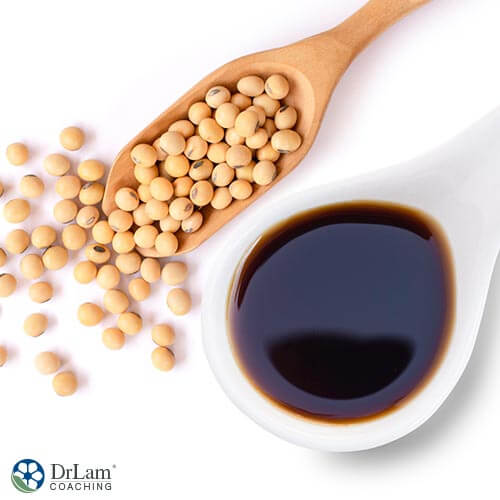A staple in Asian cooking, soy sauce has become a firm fixture in many American pantries. The salty, tangy, savory taste of soy sauce makes it not only a great enhancement to many dishes, but it is also extremely versatile! But many of us with soy or wheat allergies, or who must watch their sodium intake, need to avoid it. So, these people may feel they lose out on foods calling for a good splash of soy sauce to give it the needed flavor. What many do not realize is that they could use a soy sauce substitute. There are a few to choose from.
 Originating from China, soy sauce is made from fermented soybeans, grains, saltwater, and koji. The latter is a type of mold.
Originating from China, soy sauce is made from fermented soybeans, grains, saltwater, and koji. The latter is a type of mold.
The traditional method of making the sauce sees the beans soaked and then cooked. The grain is roasted and then finely crushed. These ingredients are then combined, the mold added, and mixed with the saltwater and left to infuse. Once infused, separation of the liquid and solids takes place, and the sauce pasteurized and bottled. Interestingly, the taste of the sauce differs, depending on the country of origin. The different varieties include thick, sweet, light, and dark.
For those not able or wanting to use soy sauce, you can use a soy sauce substitute.
Many people suffer from soy or gluten allergy or sensitivity. Soy sauce also contains high sodium levels. Consuming soy sauce in such cases could not only spark an allergic reaction or sensitivity but could also prove problematic for adrenal health. Food allergies and food sensitivities are both symptoms of adrenal fatigue. At the same time, however, each could act as a stressor.
You see, while most of us associate stress with pressure due to our work environment or even from our home life, you get different types of stress. Stress could result from your environment, our lifestyle, or even the food we eat. And stress activates our body’s NeuroEndoMetabolic (NEM) stress response which is governed by the Hypothalamic-Pituitary-Adrenal (HPA) axis in the brain.
As soon as we experience stress, the HPA, using chemical messengers, sends out a ‘we are under attack’ message that sees the NEM jump into action in an effort to protect our bodies. During this time various organs in the body, particularly the adrenal glands, release large amounts of hormones that prepare the body for this perceived attack. The major player is cortisol.
At the same time certain functions needed for fight or flight, i.e. survival, stand at attention to stave off the attack, while those functions not needed for immediate survival are either slowed down or switched off. And once the threat passes all systems return to normal. Simple, right?
But what happens when the threat does not go away?
Well, all the systems and activities activated, slowed down, or shut down during the NEM stress response continue functioning as if your body is under threat. In other words, if you continue consuming the food that you have a sensitivity towards, your body stays in a constant state of stress. In the long term, your adrenal glands cannot keep up with the constant, increasing demand for cortisol, and ultimately you reach the latter stages of adrenal fatigue. Besides showing increasing symptoms of the condition, it could lead to a decrease in cortisol production and a new, vast set of symptoms that could prove debilitating.
So, if you are allergic or sensitive to soy sauce, using a soy sauce substitute could help prevent this from happening.
If you want to eat the food and have the taste but cannot use the sauce for whatever reason, you might consider using a soy sauce substitute. There are many to choose from. Many have a taste of umami, i.e. a savory taste.
 A soy sauce substitute made from fermented coconut sap, coconut aminos is similar in flavor to soy sauce but with a slightly sweeter flavor. Coconut aminos is a good option as it not only contains 17 amino acids, it has a low sodium content. Another positive aspect, besides the fact it contains no soy, is that it does not contain any gluten.
A soy sauce substitute made from fermented coconut sap, coconut aminos is similar in flavor to soy sauce but with a slightly sweeter flavor. Coconut aminos is a good option as it not only contains 17 amino acids, it has a low sodium content. Another positive aspect, besides the fact it contains no soy, is that it does not contain any gluten.
Liquid aminos, a liquid protein concentrate made from unfermented soybeans, is a soy sauce substitute similar in taste to soy sauce although sweeter and milder in taste. This sauce, however, is not suitable for those avoiding soy sauce because of a soy allergy. Because this sauce is very concentrated, however, you would use much less than conventional soy sauce.
Although the word ‘shoyu’ in Japanese means soy, this soy sauce substitute contains no soybeans. Rather, it contains wheat, distilled sake, and sodium. This gives the sauce a thick texture. Golden in color, shoyu sauce is slightly sweet with a smell reminiscent of fruit. It is a great soy sauce substitute for those allergic to soy but not for those with a gluten sensitivity.
Fish sauce, is made either from fermented fish or krill, and has an umami-like flavor remarkably similar to soy sauce. Although relatively high in salt content, fish sauce does not contain any soybeans or gluten. It is thus a perfect soy sauce substitute for those with a soy allergy or gluten sensitivity.
Adding a few chopped anchovies to your food gives your food a savory saltiness and flavor similar to that of soy sauce.
A fermented sauce originating in Britain, this soy sauce substitute has a similar umami quality found in soy sauce. Made from malt vinegar, anchovies, tamarind extract, molasses, onions, garlic, sugar, salt, and spices, this sauce contains no soy or gluten and much less salt than soy sauce.
A firm European favorite, Maggi has long been used to enhance the flavor of just about any food. Depending on the region where it is manufactured, however, it could contain soy or wheat. This is because manufacturers of the condiment tend to adjust the recipe according to the region of sale and flavors of local foods. So before purchasing this condiment, please read the label to see whether the sauce contains soy or wheat.
Tamari is a gluten-free soy sauce substitute that contains soybeans. It is close in taste to soy sauce and made in a similar fashion.
Miso paste, a Japanese condiment, like soy sauce contains soybeans, salt, and koji. Some blends contain various grains. Although a great soy sauce substitute, it is not for those who have a soybean allergy or gluten sensitivity. You do, however, use much less miso paste in your food than you would use soy sauce.
The water from rehydrated shiitake mushrooms makes healthy gluten- and soy-free, low sodium soy sauce substitute. Although not too close in taste to the real thing, it does enhance food’s savory taste.
One of the main reasons people use soy salt is to impart saltiness to food. If this is your aim when using soy sauce, then salt makes a great soy sauce substitute containing no gluten or soy.
If none of the above alternatives meet your needs, you could always make your own soy sauce substitute in the comfort of your own home. What is more, it will last a few weeks if stored closed in your refrigerator.
You would probably have most of the ingredients for this recipe in your pantry.
Combine all the ingredients in a saucepan over medium to high heat and stir until it boils. Lower the heat and allow the sauce to simmer for 10 to 12 minutes or until the desired flavor is reached. Turn off the heat and pour the liquid into a container. You can store it in the fridge once cooled.
 If you are out of soy sauce or cannot use soy sauce due to a food allergy or sensitivity, a soy sauce substitute could help impart a similar flavor to your dish.
If you are out of soy sauce or cannot use soy sauce due to a food allergy or sensitivity, a soy sauce substitute could help impart a similar flavor to your dish.
If suffering from a soy allergy or gluten sensitivity and cannot use soy sauce, here are a few things you can do to help alleviate the situation.
If you would like to know more about or need assistance with a soy sauce substitute, the team at Dr. Lam Coaching can help. We offer a free** no-obligation phone consultation at +1-626-571-1234 where we will privately discuss your symptoms and various options. You can also send us a question through our Ask The Doctor system by clicking here.
A soy sauce substitute may help adrenal fatigue sufferers allergic to soy products or with a gluten sensitivity. But not everyone with adrenal fatigue have this allergy or sensitivity. So, while a substitute may help with adrenal support in some people, it does not necessarily apply to everyone.
